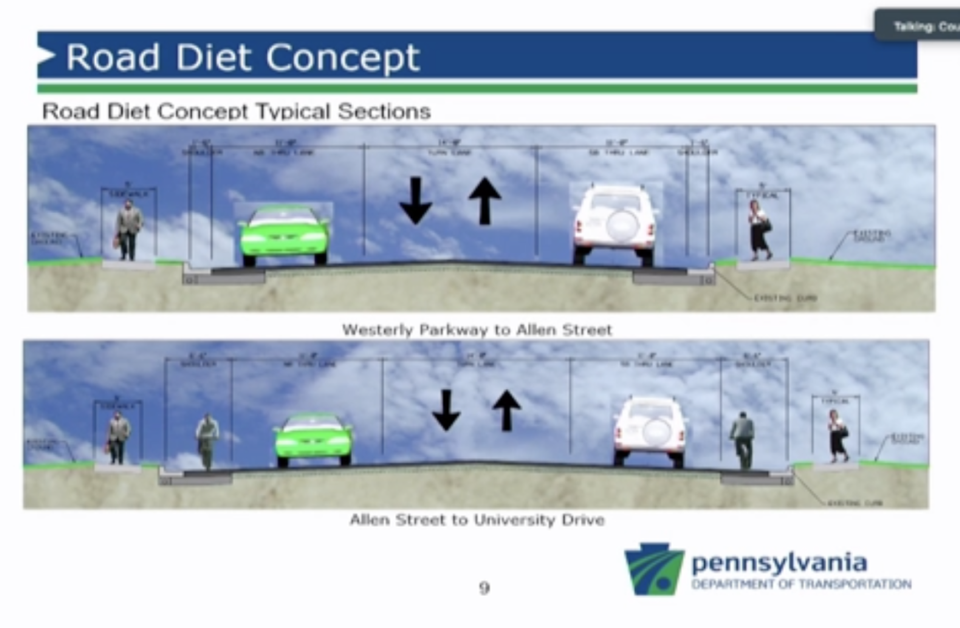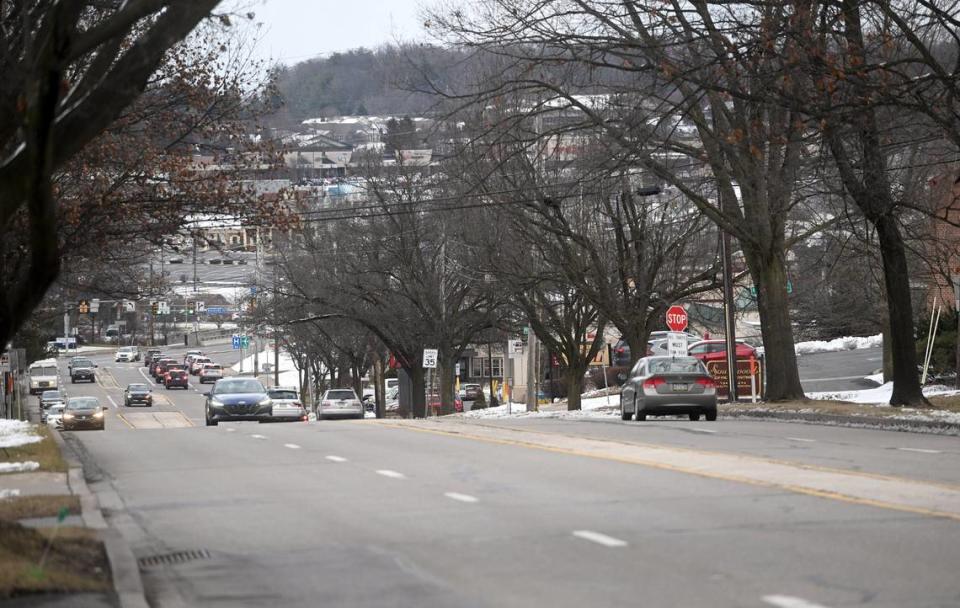Would reducing Atherton Street travel lanes improve safety? What a proposed study would do
The layout of a section of Atherton Street in State College could look very different in a few years if a proposal by the state department of transportation comes to fruition.
Jared Lapczynski of PennDOT and Lou Spaciano of Verdantas, gave the State College Borough Council an update on the Atherton Street Section 154 project during its meeting Monday. The project includes roadway and drainage improvements on Atherton Street between Westerly Parkway and University Drive.
A field survey was completed with traffic counts, Spaciano said, and they’re now looking to move to the next stage of design. He said through conversations with the borough’s transportation commission, a road diet — the removal of travel lanes or the reduction of travel lane widths to create space for other uses — came up.
The preliminary proposal is to remove a travel lane in each direction in this section of Atherton to make space for a center turning lane, though some council members have concerns about traffic problems such a change would cause.
“Essentially what we’re looking to do is provide one lane of travel in each direction and using the extra width for the center turn lane. So the key improvements are safety, operations, access and quality of life,” Spaciano said.
Currently the “first section” of the project area — Westerly Parkway to Allen Street — is two lanes in each direction. Each lane is about nine and a half feet wide. From Allen to University Drive, it gets wider with a corrugated median in the center of the road.
The preliminary concept that would be evaluated would be to make 11 foot lanes from Westerly Parkway to Allen Street, with a 14 foot turning lane.
From Allen Street to University Drive, 11 foot lanes and a 14 foot turning lane would be maintained, which would provide space for bike lanes on either side, Spaciano said.

Hugh Mose, chair of the State College Transportation Commission, encouraged the council to be supportive of the study.
“I think it’s really important to do the study. I feel bad that it was called a road diet study because in my view, and I think I can speak for the commission, it’s a safety study. It’s a capacity study. It’s a traffic congestion study. And I think the community deserves to have the study conducted so that we can make the best possible recommendations as a borough to PennDOT, who has the ultimate authority,” Mose said.
Why is a study needed?
There have been 70 reportable crashes in this section of Atherton in the last five years, Spaciano said. By removing a travel lane in each direction to provide a center turning lane, the number of conflict points on the roadway would be reduced, he said, as well as the severity of crashes.
Creating a center turning lane would also help with the overall speed differentials as the vehicles that would be stopping to turn would instead be in the dedicated turning lane. Reducing the speeds would also help other modes of transportation, like bicycles, he said.
The study would focus on the impacts of speed, level and quality of service, peak direction flows, turning volumes and patterns, for example. It will look at how traffic will operate when the lanes are removed. Other ideas and safety measures could be brought up during the study, Lapczynski said.
Spaciano said the study would last about two months and then would be submitted to PennDOT for review. It would be on a future council meeting agenda and potentially there could be a public meeting to present some of the options.
“Looking at the road diet study, you don’t have to make it a four lane into a three lane for this entire corridor. It could come up with some other ideas, other safety measures that we could implement,” Lapczynski said.
In terms of roadway improvements, the proposal includes pavement mill and overlay, full depth base replacement at some locations, curb and gutter adjustment, substandard land width improvements, cross slope correction and ADA improvements, Spaciano said.
Drainage improvements proposed are additional inlets, crowned section cross slope and gutter width, to provide 1.5 feet gutter width in the borough.
Spaciano said three intersections in the project area — Westerly Parkway, Allen Street and University Drive — have proposed signals. He said radar presence detection, pedestrian push buttons and pavement markings were among the proposals.
The funding is for the 2029 construction year. There are opportunities to move that up, Lapczynski said. The last section was a $30 million project and this section is expected to be as much as, if not more. He said they work with the Centre County MPO to program funds for the projects.

Council has mixed reaction
PennDOT ultimately has the final say in the project but went to the council for input before they start the study. A “straw vote” showed the majority of council members were in favor of conducting the study to see the results.
Council President Evan Myers lives in this area and had several concerns about the proposed project. He said people in his neighborhood would be “shocked that this is even being proposed” and said this proposal would increase traffic issues, rather than solve them. He used the area around the State College Area High School as an example.
“If you’ve ever driven there when high school is coming in or out, it’s a big traffic jam. You get behind people and people are impatient drivers. It will cause more traffic in our neighborhoods. People will be cutting off of that street because they’ll be behind trucks, behind school buses, behind traffic and they’ll get impatient, so more people will be frustrated. They’ll drive off into the Highlands, into Holmes-Foster. There’ll be more traffic, not less in those places,” Myers said.
He also worried that adding a bike lane to that section of the road would be dangerous.
“We need more bike lanes. We definitely need more ways for people to get from one place to another on bicycles, but not on the main highway. There’s plenty of neighborhood streets to folks could be driving their bikes on,” Myers said.
Council member Matt Herndon felt differently and supported the idea of a road diet.
“Making it so people can actually cross Atherton in this area, I think, is hugely important and I think this road diet is a really critical step toward that,” Herndon said. He agreed that a bike lane at the same level of traffic could be dangerous and advocated for a raised cycle lane at the sidewalk level.
Council member Josh Portney drove on that section before the meeting during rush hour and said both lanes were full. He worried that putting all the traffic into one lane would constrict the area and make it more difficult for pedestrians to cross. He agreed with the idea of a raised sidewalk.
Lapczynski and Spaciano said they’ll have more discussions before moving forward. The proposal will likely be on a future council meeting agenda. They said they’ll have a public meeting during the preliminary engineering process and during the final design.

